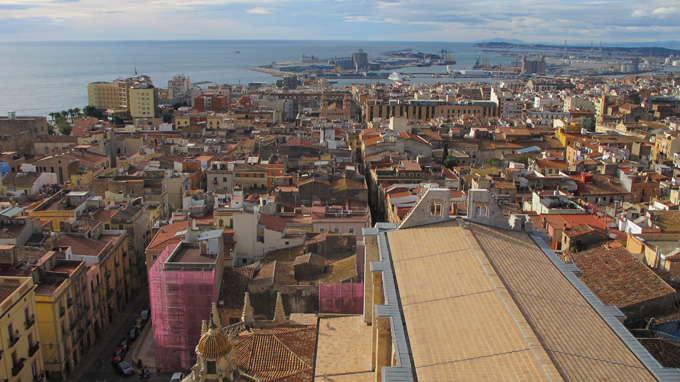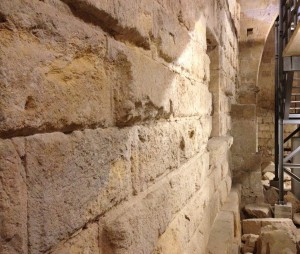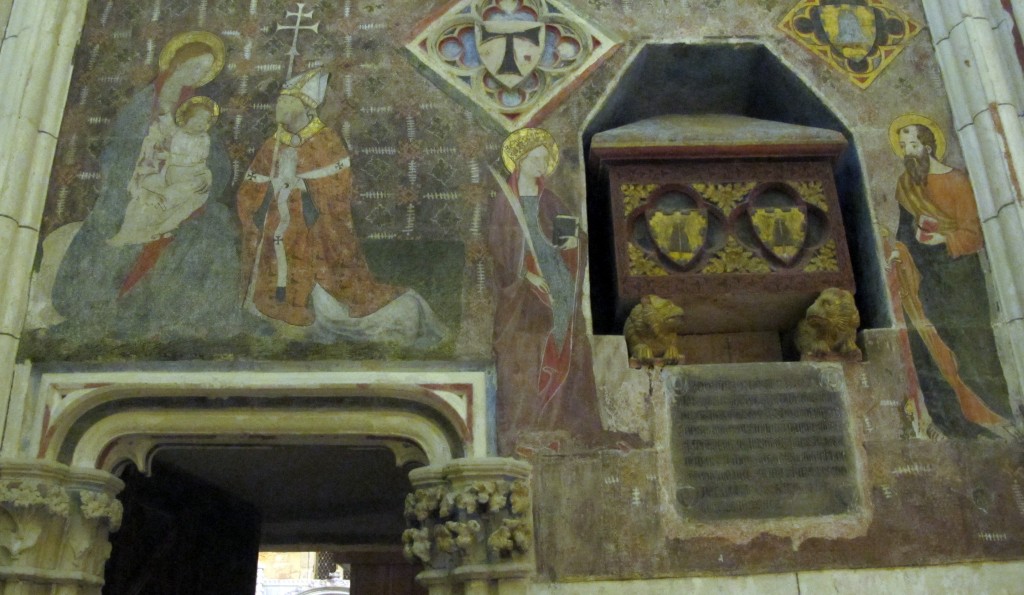We find ourselves on the highest city spot, about 70 metres high. The Mediterranean Sea is usually very quite, but today, in mid-January, it’s choppy and lively when seen from a bird’s eye view. Wind is really helping in this matter. In fact, from up above the Tarragona Cathedral bell tower, everything looks different and easier to comprehend. First, we hear four sweet peals; and then, twelve loud and long ones announcing it’s already midday. Absolute silence. We admire the view completely astonished.
Paco Tovar and Julio Villar, the Argos Serveis Culturals guides, the company behind this exclusive guided visit, point and outline Tarraco’s profile with their arms, the very first city founded by the Romans out of Italy: the walls, the Round Path, the large entrance gates, the monuments… They point at one spot or another trying to follow the roman city’s evolution during the most important periods of history it has gone through. We talk about the medieval, the Guerra del Francès (Peninsular War) siege, the way national soldiery entered the city during the civil war, and the Tarragona of today. Paco and Julio really are a fount of wisdom when it comes to anecdotes and legends: they will tell you all about them.
In order to get up here, we have gone up 196 steps on three stages. The guides are young, but considerate. While going up, we have been able to spot every scar the Cathedral preserves in its skin, indelible witnesses of the different periods it has lived through: autographs from the roman craftsmen and artisans age, all sort of ammunition’s impacts from different conflicts, graphite sketches from particular periods… Stubborn history does always repeat itself.
The Cathedral’s bell tower visit has, though, a preamble that allows the visitor to place himself. We start with the Diocesan Museum, where animage suggests where we would have been about 1.900 years ago. It is a huge leap back in time, and we struggle to travel through this kind of time tunnel. Once you have gone across the large museum entrance gate, you soon realise it is only two roman walls that are withstanding the Cathedral cloister: one, which is visible, and the other, not shown just yet due to restoration. If you are passionate about history, and you stare at the impressive roman wall, with its beautiful ashlars, you can’t help but getting goose bumps. You are right in front of a wall from the 1st century.
On the other hand, its back, the one facing the Cloister, is from the 12th century. The atmosphere it creates is original, personal, unique, and it is only to be found in a few cloisters. Opposite the Cloister’s Mother Mary’s chapel, there is a grave that will definitely attract your attention. In it, a 1641 battleship captain lays to rest, whose name was Francisco Plaza, and got everlastingly known for being “the tallest man of our time, whose stature went beyond 12 foot” (2.20 metres).
Inside the cloister, in disguise on two of the several existing capitals, you can find the “man of the three faces” and the “rats procession”. If you manage to find them, boy, are you a great explorer! If you don’t, the guide will nicely help you. The “man of the three faces” was the own sculpture’s decision who, on a particular point of the cloister, carved three faces into one, or one into three, depending on the way you look at it.
Regarding the “rats procession”, we can find a deeper meaning about it. On a first scene, the capital shows a rats procession carrying a dead cat (or at least, that is what it seems) hanging on a stick. It is a festive image, of celebration, since that cat was to torture them the way nobody else knows. On the second scene, though, the cat is devouring them. It was not dead, but only pretending. The moral has to do with temptation: we should not believe for one moment we are in control of it, because we could fall into it unexpectedly…
Before going up the 196 steps that will take us to the highest point of the Cathedral, we make a mandatory stop to admire the “Santa Tecla and Sant Pau” fresco, at the “Sastres” chapel, one of the recently restored paintings from the 14th century. It’s not the same in here than in Italy, cultural capital par excellence, where most works from that period were signed so we know to whom they belong. Our works are anonymous. The aforementioned painting does shine these days, but, not that long ago, it was merely showing two heads and you could just sense its old polychrome look. The scene is representing, on one of the sides, the Mother of God and the Baby Jesus together with the archbishop of Tarragona, Pere de Clasquerí. On the other side, “Santa Tecla and Sant Pau” are praying in front of the archbishop’s mortal remains.
At last, the bell tower climb begins. First stop, after fifty-one steps, allows us to visit the monk’s room, the spaces where the people working for the Cathedral used to live: caretakers, servants,… We are now at the roman area of the square-floored enclosure. We resume our climb for another 53 steps. We find ourselves at the clock room, where there is still the original mechanism from the 16th century, and also the one from the second clock that worked from 1882 until 1986. Paco Tovar claims both of them would still work today with a few minor repairs.
The third climb is the final one, or nearly. First of all, you enter the place where the big bells used on important religious services and local festivities are. Above of all them, right in the middle, the “Fructuosa”, from 1313, which needs two people just to turn it round. From this spot, we can finally go for the peak, only fifty-odd steps away. At the very top, there is the “Capona”, the only civic bell existing in the Cathedral, since it was paid by the local government. Its emblems report it so. And you already know what else is to come, up at the watchtower. Now, it is only for you to go and see it.
By, @irodon
Visits arrangement
Argos Serveis Culturals: (+34) 670 553 404 or reserves@argostarragona.com
Cathedral ticket office: (+34) 977 226 935 or catedraltarragona@dna.es
Days: Saturdays
Schedule: 10am, 11:30am, 4pm
Visit duration: 1h30’
Languages: Catalan, Spanish, English, French, Italian
Prices: 10€ (children and pensioners); 15€ adults
Groups: From 5 to 15 people
Twitter: Julio Villar (@Julio_VillRob) or Argos Serveis Culturals (@argostarragona)
More information:
http://www.catedraldetarragona.com
*Visits only allowed on schedule unless prior reservation.
*Translated by Artur Santos






